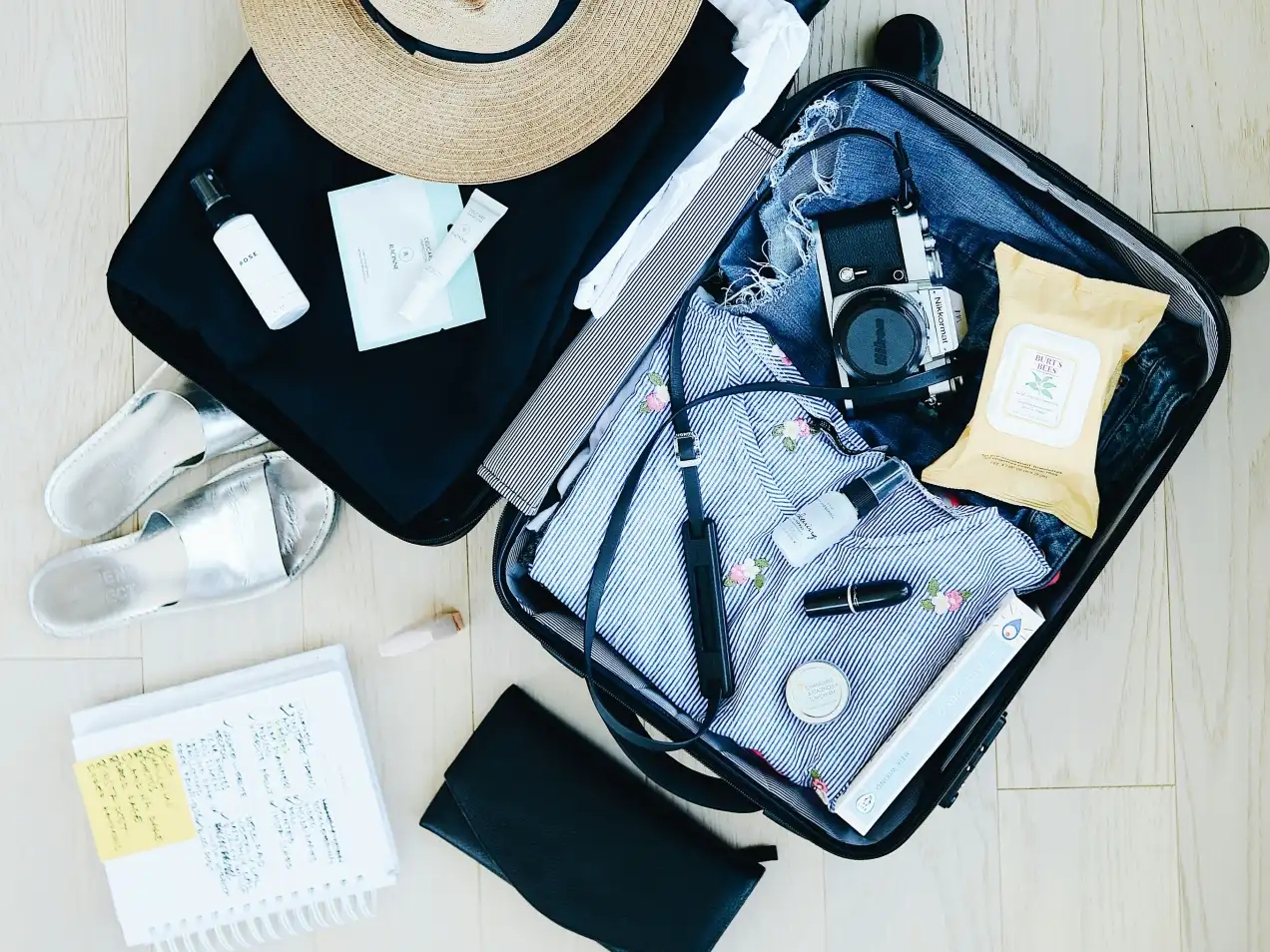
How to Pack a Carryon Like a Travel Pro
Table of Contents
Whether you’re flying, traveling by rail, or cruise ship, checking bags always comes with a wait—a cutoff time to surrender them at the terminal, and a wait for them to be delivered upon arrival. While checking bags can bring some benefits (there are fewer restrictions on liquids, for example), the wait and hassle of hauling the extra weight and bulk drives many travelers to carry on their bags only.
Here are a few strategies on traveling with just carryons—as well as a few things to watch out for when packing.
When you should travel with only a carryon
Let’s face it: traveling with just carryons is convenient. You can take your bags directly off the aircraft and head straight to transport without the bother of finding and waiting at baggage claim or wrestling large bags to and from the airport.
Traveling with only carryons works for shorter trips or travelers with limited clothing needs (such as those who will have laundry facilities available at their destination). Carryon-only travel is also easier when flying US-based airlines, which monitor the size, but not the weight, of carryon bags.
However, there are times when traveling with a carryon doesn’t work out well. Cold-weather travel, for example, is a situation where checking bags can be more convenient because of the bulky, heavy cold-weather clothing items travelers must often pack. Travelers taking significant gifts or intending to shop heavily at their destination may also appreciate the additional room of a larger checked bag.
It must also be noted that many foreign airlines—particularly those from the European Union—have stringent weight restrictions on carryon bags for economy class passengers, and they’re often closely monitored. When traveling economy class on many non-US airlines, travelers should be sure to double-check carryon weight restrictions when deciding whether or not to check a bag.
1. Choose the right bag for your needs
Size matters. In the United States, carryon bag size allowance varies slightly by carrier. Some carriers also use sizers at ticket counters and gates and periodically ask passengers to demonstrate their bags will fit sizers prior to boarding. Some ultra-low cost carriers like Spirit and Frontier Airlines also charge fees for carryon bags (but not personal items that will fit underneath a seat).
Here’s a list of current size limitations for carryon bags for most North American airlines.
- United Airlines: 9” x 14” x 22”
- Delta Airlines: 9” x 14” x 22”
- American Airlines: 9” x 14” x 22”
- Alaska Airlines: 9” x 14” x 22”
- JetBlue: 9” x 14” x 22”
- Hawaiian Airlines: 9” x 14” x 22”. Note: Hawaiian Airlines also imposes a weight limit of 25 lbs
- Southwest Airlines: 10” x 16” x 24”
- Frontier Airlines: 10” x 16” x 24”
- Spirit Airlines: 10” x 18” x 22”
- Air Canada: 23 cm x 40 cm x 55 cm (9” x 15.5” x 21.5”)
- WestJet: 23 cm x 38 cm x 53 cm (9” x 15” x 21”)
- Aeromexico: 25 cm x 40 cm x 55 cm (10” x 15.7” x 21.5”). Note: Aeromexico also imposes a weight limit of 10-15 kilos (22-33 lbs) depending on fare type
Be sure to check the weight for some carriers. Many non-US airlines impose weight limits on carryon bags, and some of them frustratingly only enforce carryon bag weight on flights to the United States. When traveling on an airline with a weight limit, be sure to adhere to the limit on all flight segments or risk having the bag checked at the gate.
Roller, backpack, or duffel?
This is a matter of personal preference, but there are some benefits and drawbacks to each.
A roller is favored by many travelers for toting convenience, especially if they prefer a duffel-style personal item that can be fitted on top as it rolls.

Rollers are further separated into further categories: rollaboards and spinners. Rollaboard bags have two wheels, while spinners have four. Rollaboard bags are generally pulled behind the traveler, while spinners can be pulled behind on two wheels or pushed on all four wheels. Spinners are generally considered to be ergonomically natural, but the additional wheels can add weight. The four wheels also tend to gum up over time and need oiling or replacing (two-wheeled bags also have the same issue, but it’s less noticeable).
Rollers also come in a variety of options, from softside to hardside and zipper-close to clamshell-style with clasps. Clamshells are more durable but are generally only available on hardside bags (which limits overpacking). Zippers, for their part, are some of the highest-mortality parts of a bag, requiring frequent replacement or repair—an inconvenience for frequent travelers.
Backpacks can be convenient, as they allow wearers to remain hands-free, but they have their hidden drawbacks. Straps and toggles can easily catch when going through security or being taken in and out of overhead bins and they can be unwieldy. Backpacks can also annoy fellow travelers. Particularly when they’re overpacked, the wearer often isn’t aware of the additional room they take up, so they have a tendency to nudge or jostle those close, especially in tight spaces. Backpack wearers should take their backpacks off upon boarding for this reason.

The pliability of a duffel can make it feel like a bottomless bag, but it can also make it difficult to find items quickly. Consider carrying a duffel with a day bag inside to give it some internal structure, with compartments for easy location of necessities. One other drawback for those with a tendency to bring more: both backpacks and duffels can exceed size limits quickly if overpacked.

2. Keep the essentials close
Some things should never go in checked luggage. If you do have to check your carryon, you’ll need to move them to your personal item. A general rule is to never check anything that’s irreplaceable, fragile, highly valuable, or whose delay would be a trip-ruiner. These include:
- Medications or medical devices (if you can’t avoid checking these, let the airline know the bag contains them; it changes the rules on how they must handle them)
- Cash and cash equivalents
- Jewelry, including watches
- Laptops, tablets, smartphones, and other electronic devices. If it has a lithium-ion battery, it shouldn’t be checked. Battery packs should be removed from “smart bags” before they’re checked
- Irreplaceable or difficult-to-replace documents (passports, birth certificates)
Airlines advise these items should not be placed in checked luggage not only because they’re difficult to replace, but because the airlines also specifically exclude them from their liability should a bag be lost, delayed, or damaged.
3. Lay out all your clothes

There’s an old packing adage that travelers should lay out all the clothes and money they plan to take on a trip, then take away half the clothes and double the money. Rai, a Flight Attendant for Alaska Airlines, softens that stance slightly: “Whatever you pack, take out one clothing item of each category before you go—you won’t miss it, but you’ll love having the extra souvenir room.”
But you should still lay out all your clothes. Organize everything into outfits and make sure every item of clothing goes with multiple outfits. Also, be sure to count the number of clothing items in each category, accounting for disasters. I once left on a round-the-world trip with only two shirts, and I ripped one on the first night, so it resulted in some last-minute shopping.
Go for dark colors for bases to hide stains; patterns also hide stains more easily than solids. Many travelers also like to leave fussy fabrics like silks, satins, and velvets at home.
If you’re doing adventures that might get dirty, bring clothes at the end of their useful life, then throw them away or donate them at your destination if they’re still in decent condition. Be careful, however, in remote destinations with limited trash removal options (Hawai’i, for example, barges much of its refuse to the Mainland, so don’t add to the local garbage problem).
The 333 Method
Going's spokesperson and resident travel expert Katy Nastro endorses the 333 Method—limiting yourself to three tops, three bottoms, and three pairs of shoes that can be mixed and matched (and accessorized) to create multiple different outfits without taking up a lot of space.
4. Be strategic with heavy items
I love to travel in a pair of wooden clogs (I like it when people can hear me coming up behind them in airports), but the moment I need to change shoes, they’re a space hog in the suitcase. Thankfully, they’re my “travel shoes,” so they rarely need to go in the bag. My sandals, which pack flat, always go in the bag to wear at the destination.
Ditto sweaters; they take up a good amount of space in the bag but are indispensable when needed. A light sweater or cardigan can always be helpful in chilled aircraft cabins or over-air-conditioned airports.
On airlines that monitor the weight of carryon bags, be sure to put heavier items in checked luggage to allow more space for items needed during the journey in carryons—after all, easy access is what they’re there for!
5. Put the bulkiest or oddest-shaped items in first
Shoes can be a good first add to a bag, as can boxes or other items that could prove difficult to shoehorn in later.
If you use packing cubes, it’s a good idea to start with these. Some travelers swear by them, especially those designed to add a little extra compression to save interior space in the bag.
6. Tuck rolled clothes where they can fit

Underwear and socks roll particularly well and can be snuggled into the remaining spaces: inside shoes, around fragile items, into corners, and down the side of a bag. On rollers, the side of the bag with the handle often creates some indentations; this is an ideal place for rolled clothing.
7. Use every nook and cranny for smaller items
Shoes are also a good place for socks, underwear, handkerchiefs, and scarves—which also helps the shoes keep their shape. The shoulders of jackets can also have their shape kept intact by stuffing them with smaller clothes. Accessories not in their own pouch can go into pockets of trousers or jackets—just don’t forget which pocket they’ve gone into!
8. Pack sample-size toiletries or buy them when you get there

Smaller toiletry sizes (less than the 3.4-ounce TSA maximum for a single liquid container) can be purchased at most drug stores and other retailers. If your favorite toiletry brands don’t come in travel sizes, several companies sell travel containers less than 3.4 ounces—just make sure the container sizes are labeled so there are no disputes at the checkpoint.
Travel expert Wendy Perrin recommends further maximizing space by traveling with multipurpose toiletries, such as 2-in-1 shampoo/conditioner and facial moisturizers with SPF.
On longer trips or for larger groups, travelers can also plan to purchase toiletries on arrival (or use the ones provided by hotels) rather than packing them.
9. Keep track of what you didn’t use, so you can leave it out next time
There’s no point carrying clothing you don’t need. Travel is also not the time to take garments that are marginal or untried. Not sure if you really like how you look in that top? Don’t pack it. When traveling it’s best to stick with tried-and-true clothing items because space is limited.
Of course, exceptions always apply. If you didn’t use that raincoat because it didn’t rain, you might want to pack it again. But if you didn’t use that raincoat because something else you packed worked just as well, perhaps it wasn’t necessary.
10. Be consistent
Consistency pops up again and again in travel. Aircraft galleys, for example, are always stocked the same so that flight attendants can find exactly what they need whether they’re boarding a 737 in Sarasota or a widebody in Singapore.
Travelers can do the same when packing. Always keep the passport in the same side pocket, perhaps, or the toiletries bag always to the right of the electronics bag, both always to the right of the day bag inside the duffel. Knowing exactly where an item is packed because that’s its permanent home will save time hunting through bags at the last minute.
11. Compartmentalize

For small items of similar types, I reuse airline amenity kits or pouches. One for toiletries, one for electronic odds and ends like power cables and headsets, and one for medications. The pouches are different colors and fabrics, so I know from both look and feel exactly which items each one contains when I’m feeling around for them unseen (you can’t always see in your carryon in a darkened aircraft cabin or a hotel room you haven’t found all the light switches in yet).
12. Don’t fear the hotel laundry
Yes, it can be expensive, but hotel laundry can keep you in clean clothes and allow you to pack less.
Most hotels return laundry or dry cleaning the same day, though this varies by location. Some big city hotels offer express or overnight service for a surcharge; some remote locations have longer turnarounds or don’t offer dry cleaning. But when you can get a pile of clothes washed for $30, or even $50, it can still be cheaper than the cost of checking a bag with extra clothes.
Published March 6, 2024
Last updated March 7, 2024
Treat your travel to cheap flights
Most deals are 40-90% off normal prices with great itineraries from the best airlines. If it's not an amazing deal, we won't send it. Sign up for free to start getting flight alerts.





